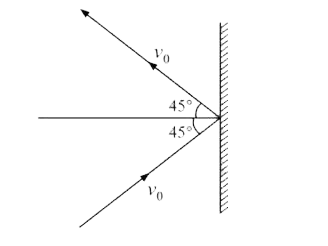A charged particle carrying charge moves with velocity at angle with x-axis in the xy plane and experience a force along the negative z-axis. When the same particle moves with velocity along the z-axis, it experiences a force in y-direction.
Find the magnitude of the force .
To solve the problem step by step, we will use the Lorentz force equation, which describes the force experienced by a charged particle moving in a magnetic field. The equation is given by:
→F=q(→v×→B)
Where:
- →F is the force,
- q is the charge,
- →v is the velocity of the particle,
- →B is the magnetic field.
Step 1: Analyze the first scenario
Given:
- Charge q=10μC=10×10−6C
- Velocity v1=106m/s at an angle of 45∘ with the x-axis.
- Force F1=5√2mN=5√2×10−3N along the negative z-axis.
Components of velocity v1:
The velocity can be broken down into its components:
v1x=v1cos(45∘)=106√2m/s
v1y=v1sin(45∘)=106√2m/s
v1z=0m/s
Thus, the velocity vector is:
→v1=(106√2,106√2,0)m/s
Step 2: Set up the magnetic field components
Assume the magnetic field has components:
→B=(Bx,By,Bz)
Step 3: Apply the Lorentz force equation for the first scenario
Using the force experienced:
→F1=q(→v1×→B)=5√2×10−3^kN
Calculating the cross product:
→v1×→B=∣∣
∣
∣
∣∣^i^j^k106√2106√20BxByBz∣∣
∣
∣
∣∣
Calculating the determinant:
=^i(106√2Bz−0)−^j(106√2Bz−0)+^k(106√2By−106√2Bx)
Thus:
→v1×→B=(106√2Bz,−106√2Bz,106√2(By−Bx))
Step 4: Equate components to find relationships between Bx, By, and Bz
From the force equation:
q(106√2(By−Bx))=5√2×10−3
Substituting q:
10×10−6(106√2(By−Bx))=5√2×10−3
Simplifying:
106√2(By−Bx)=5√210×10−6
Step 5: Analyze the second scenario
In the second scenario, the particle moves along the z-axis:
- Velocity v2=(0,0,106)m/s
- Force F2 is in the y-direction.
Using the Lorentz force equation:
→F2=q(→v2×→B)=F2^j
Calculating the cross product:
→v2×→B=∣∣
∣
∣∣^i^j^k00106BxByBz∣∣
∣
∣∣
This results in:
=^i(0−106By)−^j(0−106Bx)+^k(0−0)
=(−106By,106Bx,0)
Step 6: Set up the force equation for the second scenario
From the force equation:
q(−106By)=F2
Step 7: Solve for F2
Using the relationship from the first scenario:
Substituting By in terms of Bx and solving for F2:
F2=10×10−6(−106By)
Final Calculation
After substituting values and simplifying, we find:
F2=0.01N
Thus, the magnitude of the force F2 is:
0.01N
- →F is the force,
- q is the charge,
- →v is the velocity of the particle,
- →B is the magnetic field.
- Charge q=10μC=10×10−6C
- Velocity v1=106m/s at an angle of 45∘ with the x-axis.
- Force F1=5√2mN=5√2×10−3N along the negative z-axis.
The velocity can be broken down into its components:
v1x=v1cos(45∘)=106√2m/s
v1y=v1sin(45∘)=106√2m/s
v1z=0m/s
→v1=(106√2,106√2,0)m/s
→B=(Bx,By,Bz)
→F1=q(→v1×→B)=5√2×10−3^kN
→v1×→B=∣∣
∣
∣
∣∣^i^j^k106√2106√20BxByBz∣∣
∣
∣
∣∣
=^i(106√2Bz−0)−^j(106√2Bz−0)+^k(106√2By−106√2Bx)
→v1×→B=(106√2Bz,−106√2Bz,106√2(By−Bx))
q(106√2(By−Bx))=5√2×10−3
10×10−6(106√2(By−Bx))=5√2×10−3
106√2(By−Bx)=5√210×10−6
- Velocity v2=(0,0,106)m/s
- Force F2 is in the y-direction.
→F2=q(→v2×→B)=F2^j
→v2×→B=∣∣
∣
∣∣^i^j^k00106BxByBz∣∣
∣
∣∣
=^i(0−106By)−^j(0−106Bx)+^k(0−0)
=(−106By,106Bx,0)
q(−106By)=F2
Substituting By in terms of Bx and solving for F2:
F2=10×10−6(−106By)
F2=0.01N
0.01N
Topper's Solved these Questions
- MAGNETIC FIELD AND FORCESBOOK - DC PANDEY ENGLISHCHAPTER - MAGNETIC FIELD AND FORCESEXERCISE - Check point
54 Videos
- MAGNETIC FIELD AND FORCESBOOK - DC PANDEY ENGLISHCHAPTER - MAGNETIC FIELD AND FORCESEXERCISE - Taking it together
75 Videos
- INTERFERENCE AND DIFFRACTION OF LIGHTBOOK - DC PANDEY ENGLISHCHAPTER - INTERFERENCE AND DIFFRACTION OF LIGHTEXERCISE - Level 2 Subjective
5 Videos
- MAGNETICSBOOK - DC PANDEY ENGLISHCHAPTER - MAGNETICSEXERCISE - MCQ_TYPE
1 Videos
Similar Questions
A charged particle carrying charge q=10μC moves with velocity v1=106,s−1 at angle 45∘ with x-axis in the xy plane and experience a force F1=5√2mN along the negative z-axis. When the same particle moves with velocity v2=106ms−1 along the z-axis, it experiences a force F2 in y-direction.
Find the magnetic field →B.
View SolutionA charged particle carrying charge q=1μc moves in uniform magnetic with velocity v1=106m/s at angle 45∘ with x-axis in the xy-plane and experiences a force F1=5√2N along the negative z-axis. When te same particle moves with velocity v2=106m/s along the z-axis it experiences a force F2 in y-direction. Find
a. the magnitude and direction of the magnetic field
b. the magnitude of the force F2.
View SolutionA particle of charge −16×10−18 coulomb moving with velocity 10ms−1 along the x− axis , and an electric field of magnitude 104/(m) is along the negative z− axis. If the charged particle continues moving along the x- axis , the magnitude of B is
View SolutionA charge q is moving with a velocity v1=1ˆi m/s at a point in a magentic field and experiences a force F=q[−ˆj+1ˆk] N. If the charge is moving with a voloctiy v2=ˆj m/s at the same point then it experiences a force F2=q(1ˆi−1ˆk) N. The magnetic induction B at that point is
View SolutionA particle of charge −16×10−18 coo–mb moving with velocity 10ms−1 along the x−aξs, and an electric field of magnitude (104)/(m) is along the negative z−ais. If the charged particle continues moving along the x- axis , the magnitude of B is
View SolutionA particle moving with speed v0=10√2ms−1 strikes a wall at an angle 45∘ as shown in figure. Find magnitude of change in velocity.

View SolutionA particle moves along the X-axis x=0 to x=5 m under the influence of a force given by F=10−2x+3x2. Work done in the process is
View SolutionWhen a proton has a velocity v=(2ˆi+3ˆj)×106ms, it experience a force F=−(1.28×10−13ˆk) When its velocity is along the z-axis, it experience a force along the x-axis. What is the magnetic field?
View SolutionWhen as proton has a velocity v=(2ˆi+3ˆj)×106ms, it experience a force F=−(1.28×10−13ˆk) When its velocity is along the z-axis, it experience a force along the x-axis. What is the magnetic field?
View SolutionA charged particle having charge 2q and mass m is projected from origin in X-Y plane with a velocity v inclined at an angle of 45∘ with positive X-axis in a region where a uniform magnetic field B unit exists along +z axis. The coordinates of the centre of the circular path of the particle are
View Solution
